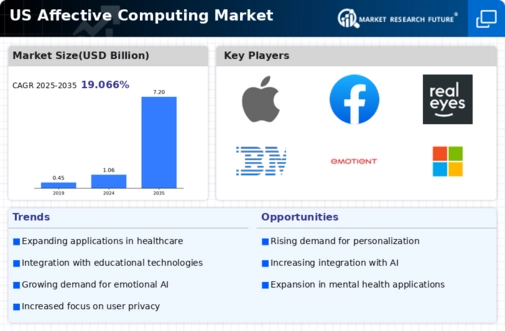The US Affective Computing Market is increasingly becoming a focal point for innovation in technology, focusing on the development of systems and devices that can recognize, interpret, and simulate human emotions. This rapidly evolving sector has drawn significant attention from technology companies, designers, and researchers, sparking a competitive landscape characterized by diverse applications ranging from mental health monitoring to user experience enhancements in digital environments. Companies are continually exploring new opportunities to incorporate affective computing into their products and services, aiming to create more personalized experiences for users.
With advancements in artificial intelligence, machine learning, and biometrics, the market is poised for substantial growth, providing numerous avenues for competitive strategies and partnerships. The blending of affective computing into everyday technology not only revolutionizes consumer interactions but also challenges existing paradigms in device functionality and engagement.
Apple has established itself as a potent player in the US Affective Computing Market, leveraging its reputation for innovation and ecosystem integration. The company has deployed affective computing technologies in various products, enhancing user interaction and experience. Its strengths lie in its strong brand loyalty, substantial investment in research and development, and the seamless integration of hardware and software within its ecosystem. Features that utilize emotion recognition allow for improved user personalization, particularly in health-focused applications aimed at monitoring emotional well-being.
Apple's commitment to privacy and user data protection has also fortuitously positioned it as a trusted vendor in a landscape that emphasizes user engagement and emotional intelligence. The company's strong market presence in the US, combined with its established distribution channels, positions it favorably to further leverage advancements in affective technology.Face++ operates within the US Affective Computing Market with a focus on advanced facial recognition and emotion analysis technologies. Its portfolio includes key products such as facial recognition systems and emotion analysis software tailored to various industries, including security, marketing, and customer service, helping organizations understand consumer sentiments effectively.
Face++ has developed a strong market presence in the US, distinguished by its technological prowess and innovative solutions in the area of machine learning. Its strengths lie in its ability to provide high-accuracy emotion detection systems that can seamlessly integrate with existing applications. Notably, Face++ has pursued strategic partnerships and mergers to enhance its technology capabilities, expanding its influence and scope within the region. Through these efforts, it has positioned itself as a significant player in the affective computing landscape, catering to the growing demand for emotion-driven technology solutions.













